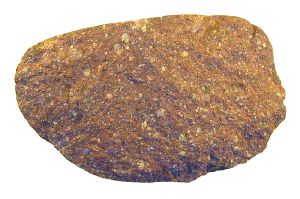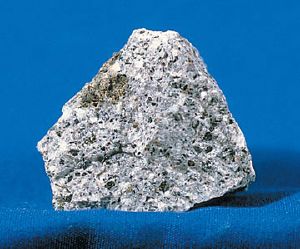Syenite

Syenite is a coarse-grained intrusive igneous rock of the same general composition as granite but with the quartz either absent or present in relatively small amounts (less than 5%).
The feldspar component of syenite is predominantly alkaline in character (usually orthoclase) . Plagioclase feldspars may be present in small quantities, less than 10%.
When present, ferromagnesian minerals are usually hornblende amphibole, rarely pyroxene or biotite. Biotite is rare, because in a syenite magma most aluminium is used in producing feldspar.
Syenites are usually peralkaline and peraluminous, with high proportions of alakali elements and aluminium.
Syenites are formed from alkaline igneous activity, generally formed in thick continental crustal areas, or in Cordilleran subduction zones. To produce a syenite, it is necessary to melt a granitic or igneous protolith to a fairly low degree of partial melting. This is required because potassium is an incompatible element and tends to enter a melt first, whereas higher degrees of partial melting will liberate more calcium and sodium, which produce plagioclase, and hence a granite, adamellite or tonalite.
At very low degrees of partial melting a silica undersaturated melt is produced, forming a nepheline syenite, where orthoclase is replaced by a feldspathoid such as leucite, nepheline or analcime.
Syenite is not a common rock, some of the more important occurrences being in New England, Arkansas, Montana, New York (syenite gneisses), Switzerland, Germany, and Norway.
Etymology
The term syenite was originally applied to hornblende granite like that of Syene in Egypt, from which the name is derived.
Episyenite
Episyenite (or epi-syenite) is a term used in petrology to describe to the result of alteration of a [[SiO2]] rich rock to a more SiO2 depleted rock. The term stems from "epi" and syenite.
The process which results in SiO2 depletion can be termed episyenitization. This process is only referring to the macroscopic result of relative SiO2 depletion in a rock. The actual physical process leading to this SiO2 depletion may vary in a given metamorphic environment. Diffusion of chemical components in a stagnant fluid, related to differences in chemical potential or pressure as well as advection of a SiO2- undersaturated fluid may lead to the dissolution of quartz from the un-altered rock, thus depleting it of this component.
See also
ReferencesISBN links support NWE through referral fees
- Blatt, Harvey, and Robert J. Tracy. 1995. Petrology: Igneous, Sedimentary, and Metamorphic, 2nd ed. New York: W.H. Freeman. ISBN 0716724383.
- Pellant, Chris. 2002. Rocks and Minerals. Smithsonian Handbooks. New York: Dorling Kindersley. ISBN 0789491060.
- Shaffer, Paul R., Herbert S. Zim, and Raymond Perlman. 2001. Rocks, Gems and Minerals. Rev. ed. New York: St. Martin's Press. ISBN 1582381321.
Credits
New World Encyclopedia writers and editors rewrote and completed the Wikipedia article in accordance with New World Encyclopedia standards. This article abides by terms of the Creative Commons CC-by-sa 3.0 License (CC-by-sa), which may be used and disseminated with proper attribution. Credit is due under the terms of this license that can reference both the New World Encyclopedia contributors and the selfless volunteer contributors of the Wikimedia Foundation. To cite this article click here for a list of acceptable citing formats.The history of earlier contributions by wikipedians is accessible to researchers here:
The history of this article since it was imported to New World Encyclopedia:
Note: Some restrictions may apply to use of individual images which are separately licensed.
